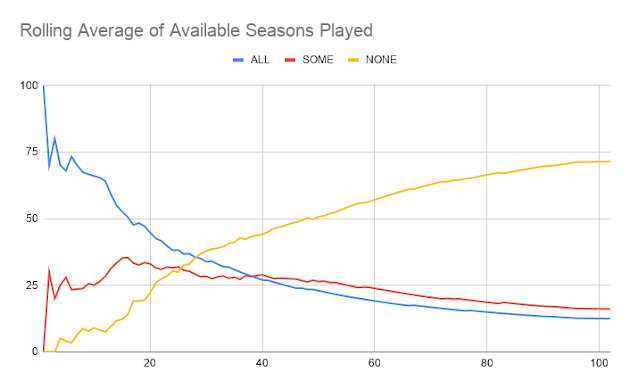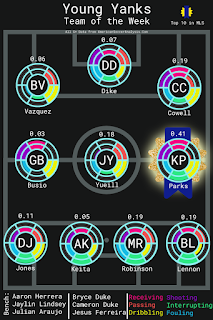US Olympic Qualifying Deep Dive Pt 3: The Fullbacks
In the modern era, there are few positions that have undergone radical change as much as the fullback. Modern fullbacks must have the defensive ability to challenge target forwards, the athleticism to stretch up field and overlap their wingers, and the technical ability to take on defenders. Though there are individual differences, like the skill and quick combination of Dani Alves or the laser accurate crossing of Trent Alexander Arnold, the keys to the position remain the same. The golden example of fullbacks in the USA is recent Barcelona signee Sergiño Dest, but there are capable options stateside as well that will contribute for the USA.
Offense vs. Defense
The fullbacks playing in MLS that could represent the USA run the gamut from more attacking types, to defenders who rarely go forward. Bryan Reynolds, the FC Dallas right back making his case for the starting position after Reggie Cannon's departure, is the most aggressive fullback in the pool. Of course, his experience as a forward and winger contributes to his comfort in the attacking third. The oft-injured Jaylin Lindsey and Julian Araujo are notably aggressive as well. Dejuan Jones and Kyle Duncan are both frequently involved in the attack. Teammates George Bello and Brooks Lennon get in the final third at the same rate, which is an interesting symmetry.
John Nelson, Marco Farfan, and Matthew Real combine defense-first position with a relative lack of experience. Aaron Herrera dwarfs all others in terms of total experience, with more than 40 full 90s under his belt as a fairly defensive fullback. Sam Vines is very experienced for his young age, but his role in the Rapids attack and buildup is extremely limited.
Duncan is the most touch dominant of the full backs, with much of the Red Bull New York buildup directly involving him. He has a tremendous combination of experience that will be tough to look past when selecting players.
Ball Progression via Carrying
Reynolds and Jones jump off the screen as clearly progressing the ball when they get the opportunity. The rest are fairly clumped in the middle, carrying the ball just a few yards forward each opportunity. Lennon pumps balls into the penalty area given the opportunity, while his teammate Bello notably rarely puts in either a pass or cross. The more defensive full backs lag behind when it comes to producing danger and bringing the ball forward.
Passing
Herrera surprises here with the number of passes into the final third. When combined with his carrying stats, it's clear that he will look for the pass rather than trying to get to the end line or find a ball into the box. Reynolds again brings the most aggressive approach, while Duncan and Nelson skew aggressive as well. Jones, Vines, and Araujo also make a large number of final third passes when the few passes they make overall is considered.
Again, Bello stands out for being fairly safe. Although he gets a great deal of media attention due to his team and his youth, he lags behind a lot of young fullbacks in terms of his ability to influence a game.
Defensive Pressing
One quick note about this graph; it shows average distance from midfield per press as a relative distance. While there is a midfield line there is no end line, and it's useful only in relation to the other players but not to the pitch. It's clear to see that Reynolds does his defensive work much higher up the pitch, while Farfan is the most defensive full back. The further up on average a fullback presses, the more frequently they seem to do so.
Duncan, Real, and Farfan are far and away the most successful pressing full backs, winning the ball for their team better than the majority of MLS fullbacks. Reynolds, Araujo, and Lennon press a great deal and high up the pitch, but rarely win it back for their team. Of course when high pressing, a lateral or backwards pass is the most common outcome, and shouldn't be viewed as a failure. Nelson's low average press line combined with his lack of success is a red flag as a defender.
1v1s Against Ball Carriers
(Tackling)
A key dimension for the USA's fullbacks will be their ability to take on opponents 1v1 defensively. CONCACAF has no shortage of quick and talented wingers to take advantage of even the slightest mistakes. Alberth Elis dominated the USA and kept them home in 2016, and avoiding a repeat of that kind of performance will be vital.
Note: The diagonal line shows how the players perform relative to each other; it is not normed for MLS defenders as a whole.
Jaylin Lindsey is not a very aggressive tackler, rarely getting in to duels, but he is in the top 10% of MLS FBs in terms of his success. Reynolds is interesting as he presses frequently but is the least frequent in the number of duels he is involved in. He also isn't particularly successful in duels, in the bottom 5% for MLS FBs. Duncan and Nelson set the standard for defending against the dribble, doing so frequently and successfully. Since Nelson is not a strong presser, it may be that he prefers to more directly challenge a ball carrier. Bello shows promise as a defender, and Araujo struggles with winning the ball for all his activity on the defensive end. It should be noted that Araujo also fouls a great deal and finds himself in yellow card trouble often. This is a danger in a tournament environment, as he could find himself suspended due to accumulation.
Putting it all together
The right back spot is probably the strongest, with Kyle Duncan being head and shoulders above the rest of the pack in terms of what the U23 team will need. He will probably have to adapt to seeing the ball less frequently than his usual 70 touches per 90, but the experience he has will serve him well. Reynolds or Lennon can be brought in as a sub, able to attack and overlap in late game situations if the USA needs a goal. Araujo is risky, still U20 eligible, and if recent reports are to be believed a potential player for Mexico.
At left back, there are a few options with different styles but none are truly great. Aaron Herrera is typically a right back, and more defensive, but could be brought in as a sub in case either starter goes down. Matthew Real has been in form but is still very inexperienced as an MLS player. Bello and Vines are still U20 eligible and are probably better off developing more as they could compete in the next Olympic tournament. Nelson and DeJuan Jones are probably the most reliable and experienced players available at left back, with DeJuan Jones offering more in the attack but being fairly average everwhere else. Jones is not a player who gets a lot of attention from the media, but he's been consistently good for New England and has the maturity of a 23 year old player.


Comments
Post a Comment